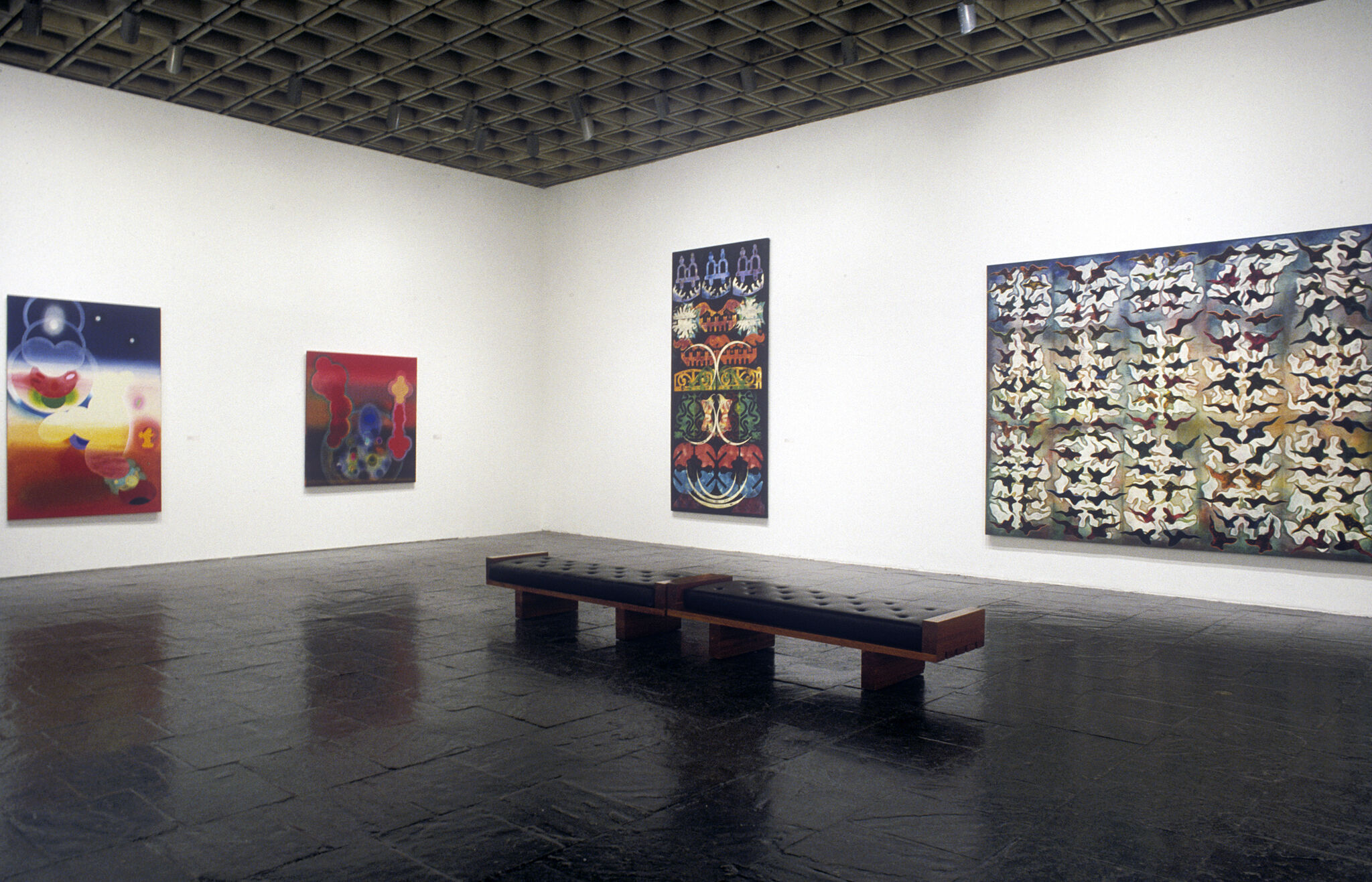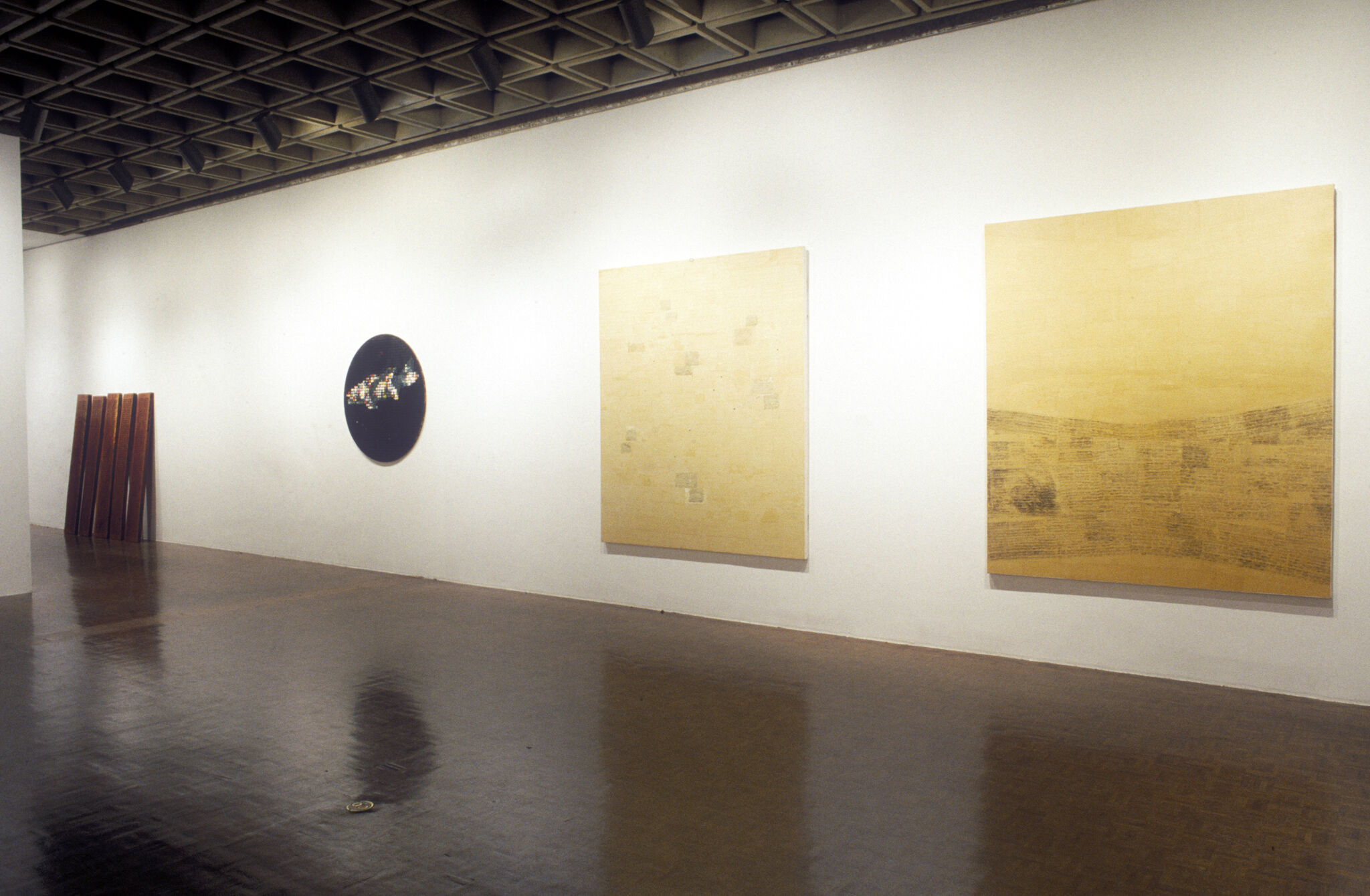Whitney Biennial 1995
Mar 23–June 4, 1995
Whitney Biennial 1995
The Whitney Biennial 1995 was curated by Klaus Kertess.
View the full exhibition catalogue at the Internet Archive.
Installation photography
-


Installation view of the 1995 Biennial Exhibition (Whitney Museum of American Art, New York, March 15–June 25, 1995). From left to right: Terry Winters, Matching Regions (1994); Terry Winters, Phase Plane Portrait (1994); Helen Marden, Untitled (1994); Helen Marden, Untitled(Rasa 2) (1994). Photograph by Geoffrey Clements
-


Installation view of the 1995 Biennial Exhibition (Whitney Museum of American Art, New York, March 15–June 25, 1995). From left to right: Stephen Mueller, Hey, Tira Mi Su (1994–95); Stephen Mueller, Next to Last Time (1994); Philip Taaffe, Stele (1995); Philip Taaffe, Black Volta (1994–95). Photograph by Geoffrey Clements
-


Installation view of the 1995 Biennial Exhibition (Whitney Museum of American Art, New York, March 15–June 25, 1995). From left to right: Sam Reveles, Hijo de Brujeria (1995); Sam Reveles, Fatherless Eurotas (1994); Lawrence Weiner; Siobhan Liddell, Installation (Three Parts) (1995). Photograph by Geoffrey Clements
-


Installation view of the 1995 Biennial Exhibition (Whitney Museum of American Art, New York, March 15–June 25, 1995). From left to right: Agnes Martin, Untitled #3 (1993); Agnes Martin, Untitled #1 (1993); Agnes Martin, Untitled #2 (1993); Charles Ray, Puzzle Bottle (1995); Lawrence Weiner, Untitled (#750) (1994). Photograph by Geoffrey Clements
-


Installation view of the 1995 Biennial Exhibition (Whitney Museum of American Art, New York, March 15–June 25, 1995). From left to right: Cindy Sherman, Untitled (1995); Cindy Sherman, Untitled (1995); Bessie Harvey, Peace (1994); Bessie Harvey, Cross Bearers (1992–93); Nancy Rubin, Mattresses and Cakes (1993); Peter Cain, Little Colonel (1994). Photograph by Geoffrey Clements
-


Installation view of the 1995 Biennial Exhibition (Whitney Museum of American Art, New York, March 15–June 25, 1995). From left to right: Carroll Dunham, Ruby Vision (1994); Bessie Harvey, Cross Bearers (1992–93); Peter Cain, Saturday Disaster (1994); Bessie Harvey, Peace (1994); Peter Cain, Little Colonel (1994). Photograph by Geoffrey Clements
-


Installation view of the 1995 Biennial Exhibition (Whitney Museum of American Art, New York, March 15–June 25, 1995). From left to right: Greer Lankin, Oh, Hi Hon (God What a Mess) (1995); Greer Lankin, More Morphine He Mumbled . . . (1995); Greer Lankin, Blue Babe (1995); Greer Lankin, Candy Darling (1995); Nan Goldin, Tokyo Love (1994–95). Photograph by Geoffrey Clements
-


Installation view of the 1995 Biennial Exhibition (Whitney Museum of American Art, New York, March 15–June 25, 1995). From left to right: Richard Serra, For Primo Levi (1992); Barry Le Va, Separated Animations: Groupings, Configurations, Proportions, Materials (Arrangements according to function) (1994–95). Photograph by Geoffrey Clements
-


Installation view of the 1995 Biennial Exhibition (Whitney Museum of American Art, New York, March 15–June 25, 1995). From left to right: Frank Moore, Niagara (1994); Sue Williams, We turn Back (1994); Sue Williams, Pink Spot (1994); Peter Saul, Last Judgement (1993); Peter Saul, God Created Woman (1994). Photograph by Geoffrey Clements
-


Installation view of the 1995 Biennial Exhibition (Whitney Museum of American Art, New York, March 15–June 25, 1995). From left to right: Brice Marden, February in Hydra (1991–94); Brice Marden, Muses (Hydra Version) (1991–94); Andrew Lord, Jug, Vase and Dish: Tasting (1994–95). Photograph by Geoffrey Clements
-


Installation view of the 1995 Biennial Exhibition (Whitney Museum of American Art, New York, March 15–June 25, 1995). From left to right: Helen Marden, Rosa #2 (1994–95); Helen Marden, Untitled (1994–95); Helen Marden, Kagera R (1994–95); Helen Marden, Kagera R2 (1994–95). Photograph by Geoffrey Clements
-


Installation view of the 1995 Biennial Exhibition (Whitney Museum of American Art, New York, March 15–June 25, 1995). From left to right: David Knudsvig, Cteno-cherrywood; Joe Zucker, Walleye (1993); Ellen Gallagher, Babble (1994); Ellen Gallagher, Afro Mountain (1994). Photograph by Geoffrey Clements
In the News
“The show [. . .] is low key. It feels spacious and respectful: each work has room to breathe and a viewer has room to think, since the emphasis is on art that doesn’t harangue you with its message.” —The New York Times
“. . . with metaphor as its stated theme and beauty as its big idea, this biennial [. . .] may make a lot of friends.” —The New York Times
“. . . tolerant to a fault.” —The Washington Post
“. . . trying to be all things to all people, showing some political art and some abstract painting [. . .]. In politics and in everyday life, being conciliatory is an important virtue, but in art it leads towards eclecticism, which is boring.” —The Burlington Magazine
More from this series
Learn more about the Whitney Biennial, the longest-running survey of American art.














